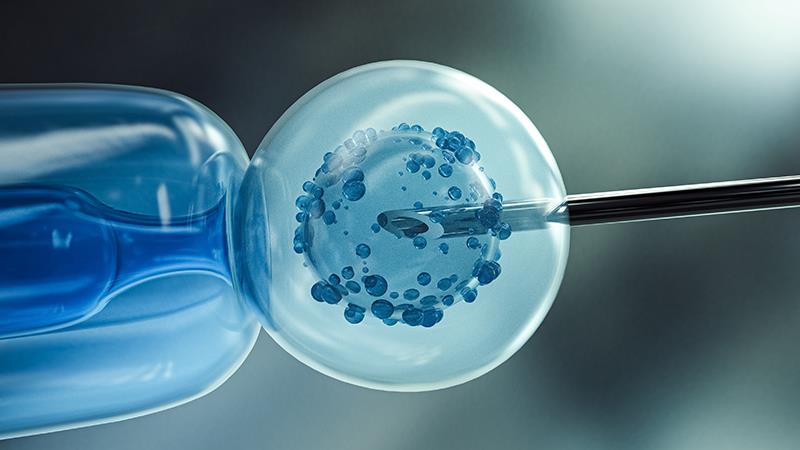Follitropin delta as good as follitropin alfa for ovarian stimulation in IVF





Follitropin delta 15 µg/day and follitropin alfa 225 IU/day as starting doses yielded similar ovarian responses in women undergoing ovarian stimulation for in vitro fertilization (IVF) or intracytoplasmic sperm injection (ICSI), according to the ADAPT-1 trial presented at ESHRE 2025.
Ovarian stimulation is a vital part of IVF treatment and is currently used worldwide. Ovarian stimulation in IVF maximizes success, patient compliance, and cost-effectiveness while minimizing the risk of adverse outcomes. [Best Pract Res Clin Obstet Gynaecol 2023;89:102341]
“[Ovarian stimulation with] follitropin delta at a starting dose of 15 µg/day was expected to provide a comparable ovarian response to follitropin alfa 225 IU/day,” said principal investigator Dr Andrea Bernabeu from Instituto Bernabeu in Spain.
The ADAPT-1 trial included 300 infertile women (mean age 34.5 years) undergoing ovarian stimulation for IVF or ICSI. Participants were randomized in a 2:1 ratio to starting doses of 15 µg/day for follitropin delta (study group; n=200) or 225 IU/day for follitropin alfa (control group; n=100) following a gonadotropin-releasing hormone (GnRH) antagonist protocol.
The mean duration of stimulation was approximately 9 days in both groups, but the mean total dose of gonadotropin used was numerically lower in the follitropin delta group (143.7 µg) than the follitropin alfa group (154.3 µg or 2,105 IU).
A total of 297 participants underwent oocyte retrieval, with embryo transfer performed in 164 follitropin delta-treated patients and 82 follitropin alfa-treated patients.
In the overall population, both treatment groups had a mean of 9.9 oocytes retrieved, indicating comparable efficacy. The per-protocol analysis showed a similar result, with both treatment groups retrieving 9.8 oocytes. [ESHRE 2025, abstract O-242]
Of note, the majority of participants achieved the targeted response of 8–14 oocytes retrieved, with 45.5 percent and 50 percent of patients in the follitropin delta and alfa groups, respectively, reaching this goal.
In a subgroup of patients with anti-Müllerian hormone (AMH), those with a lower AMH (<15 pmol/L) level had a lower mean number of oocytes retrieved than those with a higher AMH (<15 pmol/L) level. “This result was expected … and was comparable between treatment groups in both AMH subgroups,” said Bernabeu.
Three patients experienced oocyte retrieval cancellation in the follitropin alfa group, while none occurred in the follitropin delta group.
However, the transfer cancellation rate was similar in both groups (18 percent [follitropin delta] and 15 percent [follitropin alfa]). Bernabeu stated that the transfer was cancelled due to no embryos being available at the time.
In terms of the IVF laboratory parameters, the number of fertilized oocytes (5.5 vs 5.4) and the rate of fertilization relative to oocytes retrieved (55.1 percent vs 54.3 percent) were comparable between the study and control groups, as was the total number of blastocysts on day 5 or 6 (3.2 vs 3.1).
The implantation rate (39 percent [follitropin delta] vs 36.2 percent [follitropin alfa]) and the clinical pregnancy rate per started cycle (31.6 percent vs 31 percent) were also comparable between the two groups.
Adverse events
The rate of adverse events (AEs) was similar between the follitropin delta and alfa groups (36.5 percent vs 40 percent), with two serious AEs observed in the follitropin alfa group.
Headache, pelvic discomfort, and procedural pain were the most commonly reported AEs in both groups.
No AEs led to treatment discontinuation or death in the follitropin delta group.
Importantly, the incidence of ovarian hyperstimulation syndrome was low in both groups, with 2.5 percent occurring in the follitropin delta group and 3 percent in the follitropin alfa group.
“The safety profile for ovarian stimulation with follitropin delta with a starting dose of 15 μg was generally comparable with follitropin alfa 225 IU in a conventional dosing regimen,” the researchers noted.
“Overall, we found that starting doses of 15 µg of follitropin delta and 225 IU of follitropin alfa resulted in comparable ovarian responses and other clinical outcomes,” said Bernabeu. Although she stated that “dose adjustments may be applied depending on individual response when using a [GnRH] antagonist protocol regimen.”
“These trial results will help clinicians better understand the follitropin delta microgram unit compared with other gonadotropins dosed in IU, particularly for patients who have previously undergone ovarian stimulation cycles,” she added.